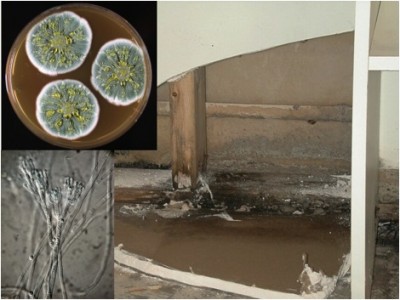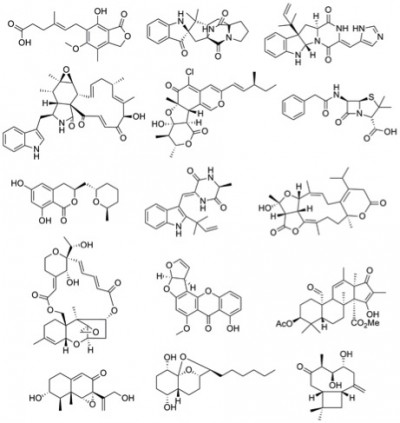
by David McMullin, Department of Chemistry, Carleton University
One of the most fascinating aspects of fungi is their ability to synthesize an array of structurally diverse, often potently bio-active compounds known as secondary metabolites. This phenomenon can be exemplified by Sir Alexander Fleming’s discovery of penicillin from an indoor Penicillium species, or our exploitation of these chemicals as pharmaceuticals including the cholesterol lowering statins. There is a growing body of evidence from large population studies that demonstrates individuals living or working in damp and mouldy buildings are at an increased risk of developing allergies and respiratory symptoms, including asthma.
Modern buildings are designed to be more energy efficient with lower ventilation rates compared to the buildings constructed 40 years ago. Many of the commonly used building materials today, including particle board and paper-faced gypsum wallboard, will become water saturated with much less water as opposed to wood and traditional plaster. This unwanted water indoors can originate from daily routine activities such as cooking and showering, undetected leaks or flooding. When the amount of water vapor in a building exceeds the buildings ability to remove it, it is absorbed by the building materials. When these building materials become damp, mould growth occurs. This is of particular importance to individuals from industrialized countries, including Canada, as we spend the majority of our time indoors
The specific fungi, or moulds that are found on damp building materials is related to ‘how damp”, the amount of time they remain damp and “nutrients” of the particular building material. As different commonly used building materials have their own unique combination of available water, nutrients and chemistry, it is not surprising that specific moulds are associated with certain materials. While the overall species diversity of fungi is considered great, the number of species found indoors is fairly small. Interestingly, as similar building materials are used in industrialized countries, the distributions of some of the more common moulds in temperate environments are also very similar.

Gypsum board is often used to construct interior walls and ceilings; however, when it becomes damp it promotes the growth of numerous moulds. The most commonly identified indoor mould, Penicillium rubens, is illustrated and is the species where the antibiotic penicillin was originally discovered from.
Since the changes in construction practices for buildings and homes in the 1970’s, evidence from large epidemiological studies conducted in multiple countries has shown that indoor exposures to dampness and moulds are associated with an increased risk for respiratory symptoms, asthma, bronchitis, respiratory infections and other non-specific symptoms. For example, the inflammatory disease asthma is commonly associated with a genetic predisposition known as atopy. However, individuals working or inhabiting a damp, mouldy building are at an increased risk for developing asthma. As a genetic predisposition and an allergy cannot explain this disease pattern, it suggests that there is a toxic effect. The production of toxic fungal secondary metabolites may explain why individuals are developing (non-atopic) asthma and other respiratory symptoms. As many of these secondary metabolites are not volatile, it additionally indicates that the exposures we experience are due to the inhalation of mould spores and mycelial fragments which harbor these biologically active chemicals.
To ask the question, “how do toxic secondary metabolites produced by moulds alter human lung biology?”, information on the identity of the moulds found indoors and the preparation of the toxic chemicals they produce are first required. During my graduate studies in Professor David Miller´s group, mould samples were collected from across Canada representing some of the most commonly identified fungi indoors. The goal of my research project was to purify the dominant secondary metabolites produced by these moulds so they could be tested for biological activity in relevant toxicological experiments. This type of work is necessary as one cannot typically go to the store and purchase these chemicals, you have to isolate them from nature yourself. The unambiguous confirmation of specific secondary metabolites from a particular species can often help fungal taxonomists, as the production of these chemicals is typically consistent within a particular species.
What I found investigating the secondary metabolites produced by some of the most frequently identified fungi in damp buildings ranged from the confirmation of potently toxic compounds known to be produced by certain species to the identification of new-to-science chemicals. Growing liters upon liters of fungi in liquid can be messy, stinky work…but it is a lot of fun. So, after extracting all of those liters of fungal culture, isolating the secondary metabolites and identifying the structures by various spectroscopic methods; I was left with a collection of fungal metabolites produced by the actual moulds found growing in Canadian buildings and homes.

Chemical diversity of the secondary metabolites produced by moulds found in damp buildings. Many of these toxic compounds have been studied for their inflammatory properties in relevant toxicological experiments.
A broad consensus has been reached by national (e.g., Health Canada) and international (e.g., World Health Organization) agencies on the impact of mould and dampness in buildings. With these pure metabolites, we can contribute to an understanding of the role they play in the documented health effects of those working or living in damp and mouldy buildings. At the very low exposures that could be experienced by the human lung indoors, induction of pro-inflammatory genes, acute inflammation and histopathological disruptions have been observed in relevant models by fungal metabolites, including many of the metabolites isolated during my graduate research. While there are some differences between various models, all results indicate that the compounds present on mould spores that we are exposed to in damp buildings are potently pro-inflammatory. The physiological mechanism of inflammation and immuno-modulatory effects caused by these fungal metabolites are still poorly understood in lung cells. These types of experiments have revealed that these toxins modulate genes involved in asthma at concentrations experienced in damp and mouldy buildings by the human lung. A concerted effort on this important human health research will contribute to a more comprehensive understanding for non-atopic asthma and other documented adverse health effects associated with indoor mould exposures in humans.
For more information, please see:
Miller JD and McMullin DR (2014) Fungal secondary metabolites as harmful indoor air contaminants: 10 years on. Applied Microbiology and Biotechnology, 98: 9953-9966.
Top image courtesy of Kookkai_nak at FreeDigitalPhotos.net